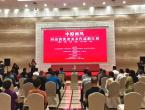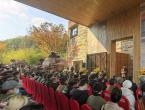Jiang Zhaoshen's Life Wandering and Artistic Return to His Hometown
In May 1994, on a cliff in the Baiyun Scenic Area of Mount Huangshan, the stone inscription "Lying Stone Covered by Clouds" began to shine brilliantly, with the inscription "Written by Jiang Zhaoshen in the autumn of Guìyǒu". From then on, Jiang Zhaoshen, this young and accomplished painter and calligrapher who had returned from afar, was forever associated with Mount Huangshan. It was precisely because I was attracted by the elegant and free-spirited calligraphy inscribed during my visit to Mount Huangshan that I gradually became interested in and approached Mr. Jiang's world of painting and calligraphy. So, when I curated the "Centennial Memory - Exhibition of Famous Huizhou Calligraphy and Painting Works" in 2018, I specially went to Wuhu to visit his childhood classmate, the architect and painter Bao Hongda, to view the works of Mr. Jiang collected by him. Recently, Huangshan City held the "Jiang Tianyi Se - Commemoration of the 100th Anniversary of Jiang Zhaoshen's Birth Calligraphy and Painting Exhibition", which is also a permanent tribute from his hometown people.
Jiang Zhaoshen (1925-1996), styled himself as Jiuyuan and named his studio Lingou Pavilion. Born in Shexian County, Anhui Province, he was a master of calligraphy, painting, seal carving, and academic research. He served as the vice president of the National Palace Museum in Taipei and concurrently as the director of the calligraphy and painting department. His poetry, calligraphy, painting, and seal carving were all exquisite, earning him the reputation as "a new typical figure of traditional Chinese literati" and "a prodigy in the history of modern Chinese art". He deeply studied traditional calligraphy and painting, and his academic achievements were renowned both domestically and internationally. In terms of creation, he integrated the rugged landscapes of the Song and Yuan dynasties, the brushwork of the Ming and Qing dynasties, and his own insights from sketches, forming a unique style characterized by a vast realm and exquisite brushwork.
"Art in Taiwan knows no bounds"
In 1949, at the age of 24, Jiang Zhaoshen made his way to Taiwan. While in Hangzhou, he attended an exhibition of Pu Xinyu's paintings and was deeply impressed. That autumn, Jiang Zhaoshen wrote a letter to Pu Xinyu, enclosing several five-character ancient poems, hoping to be accepted as a disciple to learn calligraphy and painting. However, it wasn't until 1951 that he officially kowtowed and became a disciple of Han Yutang. Pu Xinyu never formally taught Jiang Zhaoshen how to paint, nor did he ever comment on his painting practice. For 13 years, the teacher and student only discussed poetry and literature, without any painting classes. Pu Xinyu once said to him, "I have never studied painting under a teacher. If you can write good characters and compose good poems, painting is not difficult." Jiang Zhaoshen successively studied the Complete Works of Du Fu, Selected Works of Zhao Ming, Zhuangzi, Huainanzi, as well as the collected works of Han Yu, Li Shangyin, Su Shi, and Huang Tingjian, laying the foundation of scholarly education that literati must possess. He once said, "What you taught me, sir, is not just about brush and ink, but also about the mind and character." This enlightenment determined the basic direction of his future artistic path: to seek the source of innovation deep within tradition.
In 1965, Jiang Zhaoshen held his first solo exhibition of calligraphy, painting, and seal carving works at the Zhongshan Hall in Taipei. This exhibition brought him to prominence and earned him acclaim from the Taiwanese art community. Consequently, he transitioned from being an ordinary middle school teacher to working in the Calligraphy and Painting Department of the National Palace Museum in Taipei, where he engaged in the appraisal and organization of the museum's collection of calligraphy and painting, and was awarded the title of associate researcher. The rich collection of Chinese art at the National Palace Museum, coupled with his profound traditional cultural knowledge and foundation in calligraphy and painting creation, provided excellent conditions for academic research and artistic creation. Afterwards, he published numerous papers, such as "Research on Tang Yin" and "Essays on Reading Calligraphy and Painting in Shuangxi," which elevated Jiang Zhaoshen to the ranks of top-tier art history researchers. He quickly advanced from associate researcher to researcher, director of the Calligraphy and Painting Department, and vice president of the museum, and was invited to lecture and conduct professional research in the United States and other parts of the world. Meanwhile, the "Exhibition of Calligraphy and Painting Works from the United States" held at the National Palace Museum in Taipei and the "Exhibition of Calligraphy, Painting, and Seal Carving Works by Jiang Zhaoshen and Zeng Shaojie" held in Ginza, Tokyo, Japan, also greatly enhanced his reputation. In 1991, after retiring from the National Palace Museum, Jiang Zhaoshen moved to Puli, Nantou, to establish the "Jieshe Garden." Immersed in the pastoral beauty of mountains and waters, he brought a new perspective to Chinese landscape painting and the elegant aesthetics of literati. In 1992, the "Jiang Zhaoshen Calligraphy and Painting Exhibition" was held at the Taipei Fine Arts Museum, and his "Wuchen Landscape Album" was collected by the British Museum. In recognition of Jiang Zhaoshen's outstanding calligraphy and painting achievements, he was hailed as the first person after the "Three Masters Who Crossed the Sea" (Pu Xinshu, Zhang Daqian, Huang Junbi).
To capture the essence of mountains and rivers
Jiang Zhaoshen is not only a flagship figure in the realm of new literati painting, but also a calm and steadfast guardian at the intersection of tradition and modernity. He neither blindly embraces Westernization nor rigidly adheres to traditional practices. Instead, he delves into the depths of classical spirit, exploring possibilities for dialogue with the contemporary era. His landscape paintings, at first glance, exude a profound ancient charm, yet upon closer inspection, reveal a novel spatial awareness and visual structure. This creative philosophy of "using the past to open up the future" has enabled him to build a bridge between tradition and modernity. The renowned calligrapher and painter Xie Zhiliu once commented, "Using the ink of the Qing Dynasty, employing the hills and valleys of the Song Dynasty, and infusing it with the spirit and charm of the times."
Jiang Zhaoshen advocated the integrated mode of literati painting, poetry, calligraphy, and seal. His calligraphy was not only a complement to the painting, but also an organic component of the composition. Starting from his youth when he practiced Ouyang Xun's regular script, he continued to explore ancient seal characters even in his seventies. His regular script interprets the brushwork of the Ou style, exuding an elegant temperament; his running script draws inspiration from the Jin and Tang dynasties and is influenced by Huang Tingjian of the Song Dynasty, featuring a slanted style and expressing a "beauty beyond beauty" appearance. His inscribed poems are not just elegant embellishments, but extensions and deepening of the painting's artistic conception. In his early years, he studied the paintings of the Song and Yuan dynasties deeply, mastering rigorous brushwork techniques; in his middle age, he gradually formed his unique "ink skeleton" style - using calligraphic lines to construct the framework of the painting and using ink rendering to create a spatial atmosphere. Mr. Qi Gong praised him, saying, "He brings the spirit to life in landscapes, bringing the spirit to life in beautiful scenery." Based on his copying of famous paintings and calligraphy works from past dynasties, Jiang Zhaoshen attempted to achieve new order and principles through the understanding and experience of natural sketches, amidst the changes in brushwork and ink application. After returning to Taiwan from a visit to the Mount Huangshan scenic area in 1993, he created several paintings depicting the scenery of Mount Huangshan. The seal "Wuwai Zhenyou" expresses Mr. Jiang's hope to gain authentic feelings through travel and experience.
The hometown is full of unforgettable emotions
Although the two sides of the Taiwan Strait were isolated for a long time and could not communicate for decades, this did not prevent Mr. Jiang from cherishing and yearning for his hometown's ancestors, relatives, friends, and homeland. In his paintings and calligraphy works, he often inscribed poems by the ancient scholar Xu Chengyao, and he also frequently affixed seals such as "Shezhou Jiang Family", "Yansi", "Ancient Huizhou", and "Mount Huangshan" to his works, expressing his homesickness through them. In his painting "Rock Cloud" from 1991, he recorded two poems by Xu Chengyao titled "Wenshu Temple" and inscribed: "Recently, maritime restrictions have gradually eased, and many of my former students and friends have traveled to Mount Huangshan in Anhui Province and created paintings of it. As a traveler who has not returned yet, I often sigh with emotion, and thus I inscribe these poems to express my feelings.".
In 1993, Jiang Zhaoshen was invited by the Palace Museum in Beijing to hold a calligraphy and painting exhibition at the National Art Museum of China, and later the exhibition moved to the Huangshan City Museum, finally returning to his hometown after nearly 50 years of absence. The old Jiang family house, with its broken walls and dilapidated remains, and the desolate garden plot, gave Jiang Zhaoshen a dreamlike feeling as he wandered through the garden. He wanted to rebuild his painting studio on the old site so that he could often come to rest in the future. Jiang Zhaoshen wrote to Bao Hongda, telling him that after the house was built, they would live together and go to Mount Huangshan to paint for several months a year. At that time, there would be more artistic exchanges and they would climb to the higher peaks of art. Unfortunately, when the "Xinxiu Mountain Residence" was completed, Mr. Jiang had not yet cut the ribbon personally before he passed away. On the 20th anniversary of Mr. Jiang's death, Bao Hongda combined some of the works published in Taiwan's art album with some of the works exhibited during Mr. Jiang's first return to the mainland and published them in a book titled "Looking Back", expressing his eternal remembrance of Mr. Jiang. (The author is the Vice Chairman of the Anhui Provincial Literary and Art Critics Association.)
Copyright Notice: Original content on this website is welcome to be reposted. Please indicate the source when reposting, Global Art Network www.caanets.com; Some of the content posted on this website comes from the internet. If there is any infringement, please contact this website to delete it.




